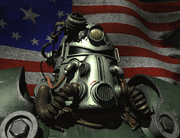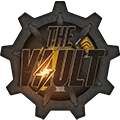| This is a lore summary, presenting intradiegetic or in-universe information about the subject. For game characteristics and similar data, consult the table on the right. |
T-51 powered combat infantry armor[1][2] is the most advanced operational power armor type developed before the Great War by West Tek on contract from the United States government.
Background[]

United States soldier in power armor
After the successful deployment of the T-45 power armor in 2069, West-Tek started development on an improved model of power armor. In 2074, the aging T-45 model proved insufficient to overcome the Chinese defenders. The T-51 model power armor remained in development, with various production models being tested in combat conditions at Fort Strong in Massachusetts, troubleshooting the design. A prototype tested in September 2075 had the desired mobility and protection, but were far from stable and soldiers tended to tip over on hard landings. Gyroscopic stabilizers and shock absorbers were subsequently added.
These problems were eventually ironed out and the joint efforts of West Tek and Fort Strong resulted in the first production run of T-51 power armor being sent to China in June 2076. It outperformed the T-45 in every aspect, providing the United States with the means to overcome Chinese resistance on all fronts. Many units were sent to China, where the renewed American offensive finally sent the People's Liberation Army into retreat. In January 2077, General Constantine Chase completed the Anchorage Reclamation, using troops fielding winterized T-51b power armor as spearhead to minimize causalities. [3][4] The renewed offensive on the Chinese mainland has also sent the PLA into full retreat after supply routes from countries it annexed broke down totally.[5][6] In addition to the war against the Chinese, units in T-51 were also deployed to quell attacks by Canadian freedom fighters who were resisting the U.S.A.'s annexation of Canada.
However, the U.S.A. found the T-51s was too difficult to produce in enough numbers to fulfill the needs of its various war efforts. To supplement this, the U.S.A. quickly developed and deployed the T-60 power armor. While the T-60 was not as advanced as the T-51, its ease of production allowed it to be produced and deployed more extensively.[7]
After the Great War, the T-51 would continue to serve with distinctions with factions that had access to it. Its principal operator is the Brotherhood of Steel, with Brotherhood T-51b armor being standard issue. It was also the service armor of the Enclave until the deployment of advanced power armor of its own design, at which point the T-51 was relegated to training and logistical duties. Some factions and wastelanders also possess the armor in limited quantities.
Design[]
The T-51[1] is the apex of pre-War powered combat infantry development. Developed over a decade of war by West-Tek, it incorporates many of the lessons gleaned from the T-45 power armor service history. Unlike its predecessor, the T-51 benefits from a long development cycle and uses custom-made components to create not a stop-gap model, but a weapon that provides the best possible protection through incorporating the latest passive defense features.[8][9][5][2]
Like the T-45, it is designed for a single human operator, patterned after the human silhouette. Unlike its older sibling, the exterior shell is made from a poly-laminate composite capable of absorbing over 2.5 kilojoules of energy without damage. The strength of the material is further enhanced by the organic, rounded profile of the shell, improving the chances of deflecting projectiles and explosions compared to the older steel plating present on the T-45. The shell is coated in a 10 micron silver ablative layer that allows for reflecting laser blasts and radiation emissions without damaging the composite surface directly.[2][10] The surface can be treated in a special chemical process to increase its defensive properties substantially.[11] To further enhance protection against direct contact with and contamination by radioactive, biological or chemical substances, the armor can be made air tight, allowing its operator to explore even the most contaminated areas with reasonable safety as long as the armor is not compromised.[12] The helmet is an integral part of this protection, fitted with a rubberized cowl mounted to the chest plate and providing a tight seal. As with all T-series, the vision slit is bullet-proof.[13] Compared to its predecessor, the helmet is smaller and more durable, made out of a single piece of composite, with an easily removable vision assembly. As with the T-45, the ear ports double as accessory mounting points, with a drop-down aiming ocular being standard on all T-51 suits. A forehead-mounted lamp is provided for convenience.
The T-51's ace in the hole is the hydraulics system integrated into the West Tek power armor frame.[14] Powered by a back-mounted TX-28 Micro-Fusion Pack generating 60,000 watts, the HiFlo hydraulics integrated into the frame of the suit allow it to carry the bulk of the suit and allow the soldier to carry heavy weapons into combat. Due to the design of the T-51, it's much more nimble and agile than the T-45.[2] However, to achieve optimal performance, the armor has to be custom-fitted to each operator.[11] A properly fitted armor worn by a well trained operator feels like an extension of one's body.[15] Comfort is imperative to success in combat operations, aided by the power armor's ability to recycle urine into perfectly drinkable water, allowing the operator to survive for weeks in power armor.[16] [17]
Variants[]
T-51 model B[]
The most ubiquitous model of power armor typically features a solid olive green livery on the breastplate and pauldrons, with the base light gray on the limbs and helmet. It is the apex of pre-War power armor design.
Winterized T-51 model B power armor[]
A pre-War variant of the T-51b power armor adapted for fighting in Arctic environments. The most noticeable difference is that the armor is painted a pale blue hue to blend in with the snowy environments and bears explicit livery of the United States Army (Army stars on the pauldrons and the national flag below the TX-28 fusion pack. The serial number is also printed on the left side of the chest plate.
Brotherhood T-51 model B power armor[]
A post-War variant of the T-51b, used by the Brotherhood of Steel as its service armor in New California and children chapters of Lost Hills. The olive green coloring of the armor has faded entirely and was replaced with a pale gray color overall. Brotherhood suits are kept in a state of good repair, with the usual streaks of rust and damage found on suits in the wasteland noticeably absent. The Brotherhood sigil is painted on the left pauldron, as per standard practice.[18]
Ultracite power armor[]
A post-war, upgraded variant of the T-51 that uses Ultracite in its design. This variant was developed by both the Brotherhood of Steel's Lost Hills and Appalachia chapters. The upgrades pushes the T-51's performance far higher than previous versions.
Behind the scenes[]
- The game and cutscene model of the armor was created by Tramell Ray Isaac for Fallout.[19]
- The drop-down optic on the helmets is directly taken from a similar optic used by a cult in the film The City of Lost Children.[20]
- In Van Buren, the appearance of the armor was slightly changed. Joshua Sawyer justified the decision as follows:
We tried to model the power armor as T-Ray did in the opening movie and game, but he could get away with clipping that would look really bad at close distances or certain angles. Simply put, building the Fallout power armor as it originally looked would have resulted in a suit with a tiny range of motion or a hilarious amount of clipping. We changed as much as we needed to allow for more flexibility in movement, but tried to stay very close to the original design whenever possible.
”Gallery[]
Fallout[]
Rhombus, the head paladin of the Lost Hills BoS.
A paladin of the Brotherhood of Steel
Fallout 2[]
Tribal with a broken T-51b helmet
Enclave soldiers in advanced power armor in front of a pre-War poster depicting the T-51b
Fallout 3[]
Van Buren[]
Fallout Tactics[]
Fallout: New Vegas[]
A group of Brotherhood soldiers in the Mojave Wasteland.
Fallout 4[]
Fallout 76[]
References[]
|
|
|
| ||||||||||||||||||||||||||||||||||||||||||||
| |||||||||||||||||||||||||||||||||||||||||||||||||||||||||||||||||||||||||||||||||||||||||||||||||||||||||||||||||||
| |||||||||||||||||||||||||||||||||||||||||||||||||||||||||
| ||||||||||||||||||||||||||||||||||||||||||||||||||||||||||||||||||



































